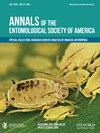水葫芦蚱蜢中心融合和异染色质多态性的c -带特征(直翅目:蝗科)
IF 1.8
3区 农林科学
Q1 ENTOMOLOGY
引用次数: 0
摘要
摘要水信子蚱蜢(Cornops aquaticum,直翅目:蝗科)在其广泛地理分布的最南端表现出3个Robertsonian易位(中心融合)多态性的临床变异。它是一种新热带半水生蚱蜢,只在北纬23°(墨西哥南部)和南纬35°(阿根廷中部和乌拉圭)之间的Pontederiaceae科或水葫芦科的漂浮植物上生活、觅食和产卵。鉴于Pontederia(原Eichhornia) crassipes的入侵物种地位和这些蚱蜢的贪婪性,它们被认为是除其他天敌外潜在的生物防治剂。我们已经描述了重排与地理和气候变量、表型变异、三价取向、对重组的影响以及与微卫星变异性的关系。在这里,我们分析了组成型异染色质在两个种群中的分布,以便(i)提供一致的标记,以便更好地区分所有染色体,那些参与中心融合的染色体和那些不参与中心融合的染色体,以及(ii)描述c阳性多余片段的可能多态性,因为在常规染色分析中,经常发现异型常染色体二价体。细胞遗传学分析使我们能够获得组成异染色质分布的详细特征,提供明确无误的大的、融合的染色体标记,以及c阳性的、多态的多余片段。本文章由计算机程序翻译,如有差异,请以英文原文为准。
C-banding characterization of centric fusion and heterochromatin polymorphisms in the water-hyacinth grasshopper, Cornops aquaticum (Orthoptera: Acrididae)
Abstract The water-hyacinth grasshopper, Cornops aquaticum (Orthoptera: Acrididae), shows a clinal variation for 3 Robertsonian translocation (centric fusion) polymorphisms in the southern extreme of its wide geographical distribution. It is a Neotropical semiaquatic grasshopper that lives, feeds, and lays eggs exclusively on floating plants of the family Pontederiaceae, or water-hyacinths, between 23° N (Southern Mexico) and 35° S (Central Argentina and Uruguay). Given the invasive-species status of Pontederia (formerly Eichhornia) crassipes and the voraciousness of these grasshoppers, they were considered as a potential biological control agent in addition to other natural enemies. We already described the association of the rearrangements with geographical and climatic variables, phenotypic variation, trivalent orientation, effects on recombination, and relationship with microsatellite variability. Here we analyze the distribution of constitutive heterochromatin in 2 populations of C. aquaticum in order to (i) provide consistent markers for a better distinction between all chromosomes, those which are involved in the centric fusions, and those which are not, and (ii) describe possible polymorphisms for C-positive supernumerary segments, given that, on conventional staining analysis, it was frequent to find heteromorphic autosomal bivalents. The cytogenetic analysis allowed us to get a detailed characterization of the constitutive heterochromatin distribution, providing unmistakable chromosome markers of the large, fusion-bearing chromosomes as well as the C-positive, polymorphic supernumerary segments.
求助全文
通过发布文献求助,成功后即可免费获取论文全文。
去求助
来源期刊
CiteScore
4.90
自引率
0.00%
发文量
25
审稿时长
6-12 weeks
期刊介绍:
The Annals of the Entomological Society of America exists to stimulate interdisciplinary dialogue across the entomological disciplines and to advance cooperative interaction among diverse groups of entomologists. It seeks to attract and publish cutting-edge research, reviews, collections of articles on a common topic of broad interest, and discussion of topics with national or international importance. We especially welcome articles covering developing areas of research, controversial issues or debate, and topics of importance to society. Manuscripts that are primarily reports of new species, methodology, pest management, or the biology of single species generally will be referred to other journals of the ESA. The most important criteria for acceptance are quality of work and breadth of interest to the readership.

 求助内容:
求助内容: 应助结果提醒方式:
应助结果提醒方式:


